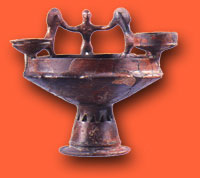|
 The
building contains one of the most important collections
of sculptures, paintings, mosaics and bronzes
of the world. The history of the building is long
and fascinating. The
building contains one of the most important collections
of sculptures, paintings, mosaics and bronzes
of the world. The history of the building is long
and fascinating.
The viceroy duke of Ossuta started its construction
on the empty S. Teresa hill in order to build
cavalry barracks. Because of insufficient water
supply this project failed. The works started
again with the viceroy count of Lemos, who assigned
the management to the architect Domenico Fontana;
the count decided to use it as Studies Palace
(1616). Untill 1777 the building was University
Seat; Gianbattista Vico thaught here from 1697
to 1701. The birth of the museum of classic antiquities
is linked to Charlesoof Bourbon.
In 1738 he decided to build a museum in the capital
of his reign; he first thought about Capodimonte
hill as the seat for the museum that had to hold
the Farnese collection. The king inherited this
collection by his mother Elisabetta Farnese.
The treasures of Ercolano, Pompei e Stabia were
discovered in the third - fouth decade of Eighteenth
century. These tows were covered by Vesuvius eruption
in 79 b.C. Charles of Bourbon promoted the excavations
that increased the prestige of his reign.
The discover of archeological sites made necessary
to locate a building in which collecting the neverending
quantity of finds. At the beginning the Palace
in Portici was chosen; soon the idea to join in
one building the archeological and art materials
with the Farnese collections preserved in Capodimonte
was accepted.
The building on Santa Teresa hill became officially
the new museum thanks to king Ferdinando IV.
From 1780 to 1820 the architects Fuga and Schiantarelli
ordered a series of restorations changes. In 1817
the Borgia Collection from Velletri was added;
it was a small but important collection of Egyptian
antiquities. In 1822 in a solemn cerimony marble
and bronze statues wound on chariots pulled by
oxen from Portici to the old Studies Palace in
the crowd.
In 1860 the museum was acquired by the State.
|




 The
building contains one of the most important collections
of sculptures, paintings, mosaics and bronzes
of the world. The history of the building is long
and fascinating.
The
building contains one of the most important collections
of sculptures, paintings, mosaics and bronzes
of the world. The history of the building is long
and fascinating.